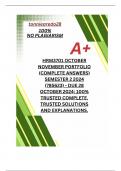,1. TASK 1: POOR RAJ (13 marks) Read through the following case study and
answer the questions that follow. Poor Raj Raj Kumar is a new recruit from a
reputed management institute, who was recruited as a sales trainee in an
office selling large computer hardware located in Pretoria. Thabo is the sales
manager responsible for overseeing the work of the sales officer, field
executives and more than 70 trainee salesmen who operate in three areas,
namely Pretoria, Centurion and Menlyn. The sales growth of the products in
his area was highly satisfactory owing to the developmental initiatives taken
by government agencies in spreading computer education. Thabo had
collected several sales reports, catalogues and pamphlets detailing the types
of office equipment sold by the company for Raj’s reference. On Raj’s first day
at work, Thabo introduced himself and showed Raj to his assigned desk and
provided him with the material collected. Thereafter Thabo excused himself
and did not return. Raj, feeling alienated and unsure of what was expected of
him, scanned through the material given to him until 5:00 pm before leaving
the office. 1. What do you think about Thabo’s training programme? Why is it
adequate or inadequate? Do you think Raj will benefit from this type of
training? Explain. (2) 2. Provide a detailed programme of what Raj’s first day
should have looked like. (11) 2.
1. Analysis of Thabo’s Training Program
Inadequate Training Program
Thabo's training program for Raj is inadequate for several reasons:
Lack of Guidance and Support: After introducing Raj to his desk and providing him
with materials, Thabo excused himself and did not return. This indicates a lack of
ongoing support and mentorship that is crucial for new recruits. Raj was left to navigate
his first day without any guidance, which can be overwhelming and lead to feelings of
alienation.
No Structured Orientation: An effective training program typically includes a
structured orientation that introduces new employees to the company culture, policies,
and expectations. Raj’s experience lacked any formal orientation, leaving him unsure of
what was expected from him in his new role.
Absence of Practical Training: The program relied heavily on providing materials such
as sales reports and catalogs without offering hands-on training or shadowing
opportunities. Practical training is vital for sales roles, where understanding the product
and customer interactions are key.
, Poor Communication: Thabo did not communicate further with Raj after the initial
introduction. Ongoing communication is essential for addressing questions and providing
feedback, which helps new employees acclimate to their roles.
Conclusion on Raj's Benefit: Given these shortcomings, Raj is unlikely to benefit significantly
from this type of training. Without proper guidance, structured orientation, and opportunities for
practical application, Raj may struggle to understand his role and the expectations of the job,
which could hinder his performance and job satisfaction.
2. Detailed Program for Raj’s First Day
Here is a suggested program for what Raj's first day should have looked like:
Morning
9:00 AM – Welcome Session:
o Raj is welcomed by Thabo and introduced to the team.
o Overview of the company’s mission, vision, and values.
o Explanation of the company culture and expectations.
9:30 AM – Office Tour:
o Guided tour of the office, including important locations such as meeting rooms,
break areas, and emergency exits.
o Introduction to key personnel in other departments (e.g., marketing, customer
service).
10:00 AM – Introduction to Sales Role:
o Thabo discusses the sales team structure and Raj’s specific role within it.
o Overview of products and services offered by the company, including a
discussion of their unique selling points.
10:30 AM – Training on Sales Tools:
o Training session on the company’s sales tools and software.
o Introduction to customer relationship management (CRM) systems used for
tracking sales and customer interactions.
Midday
11:30 AM – Shadowing Opportunity:
o Raj shadows an experienced sales executive during client calls or meetings to see
practical applications of the training.
12:30 PM – Lunch Break:
o Team lunch or informal gathering with other sales trainees to foster relationships
and build camaraderie.
Afternoon
1:30 PM – Product Training Session:





